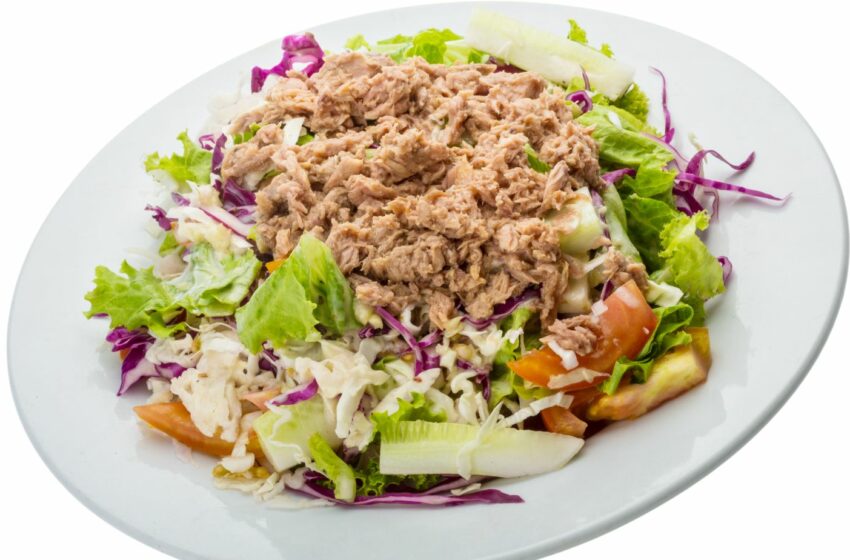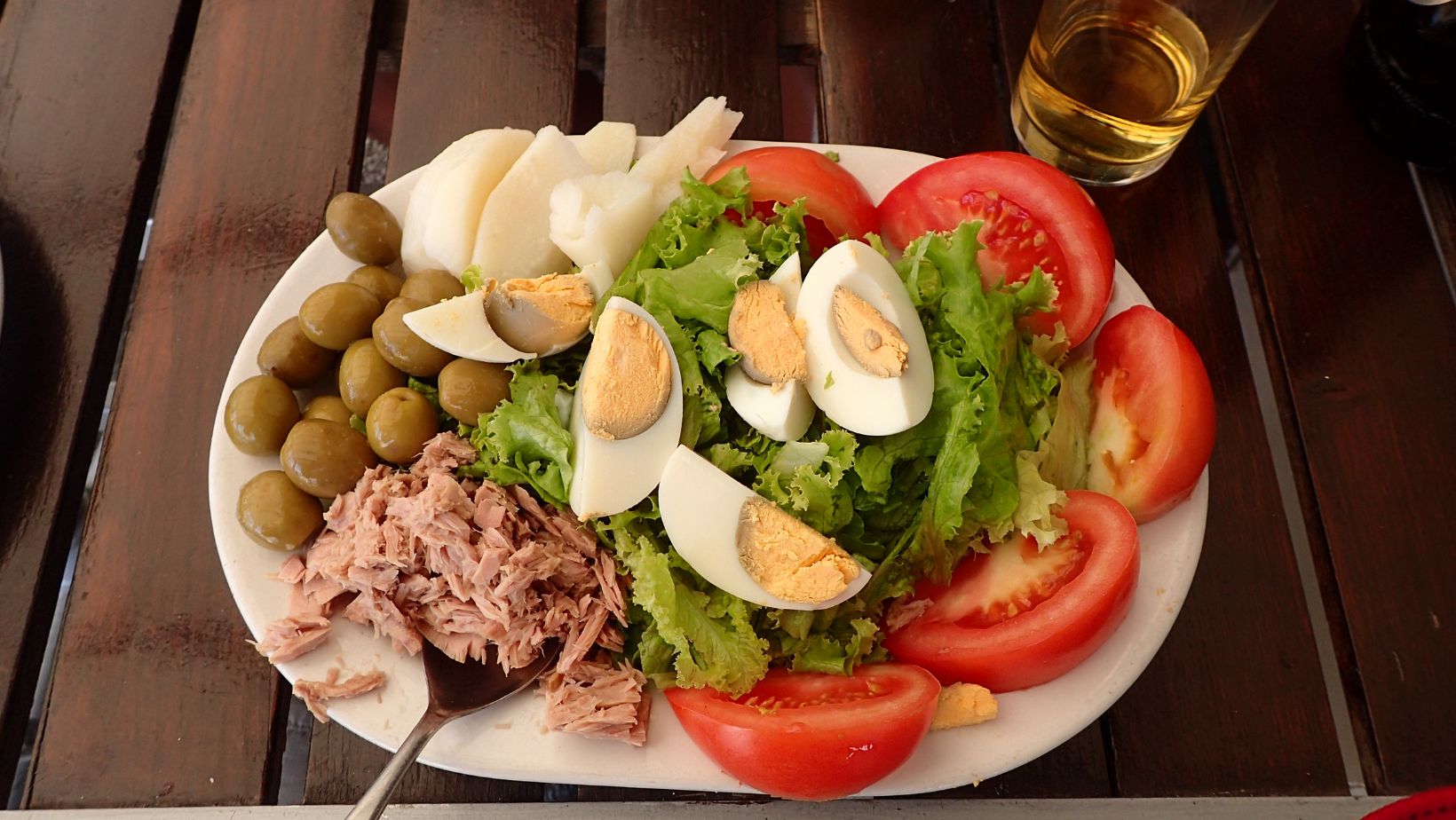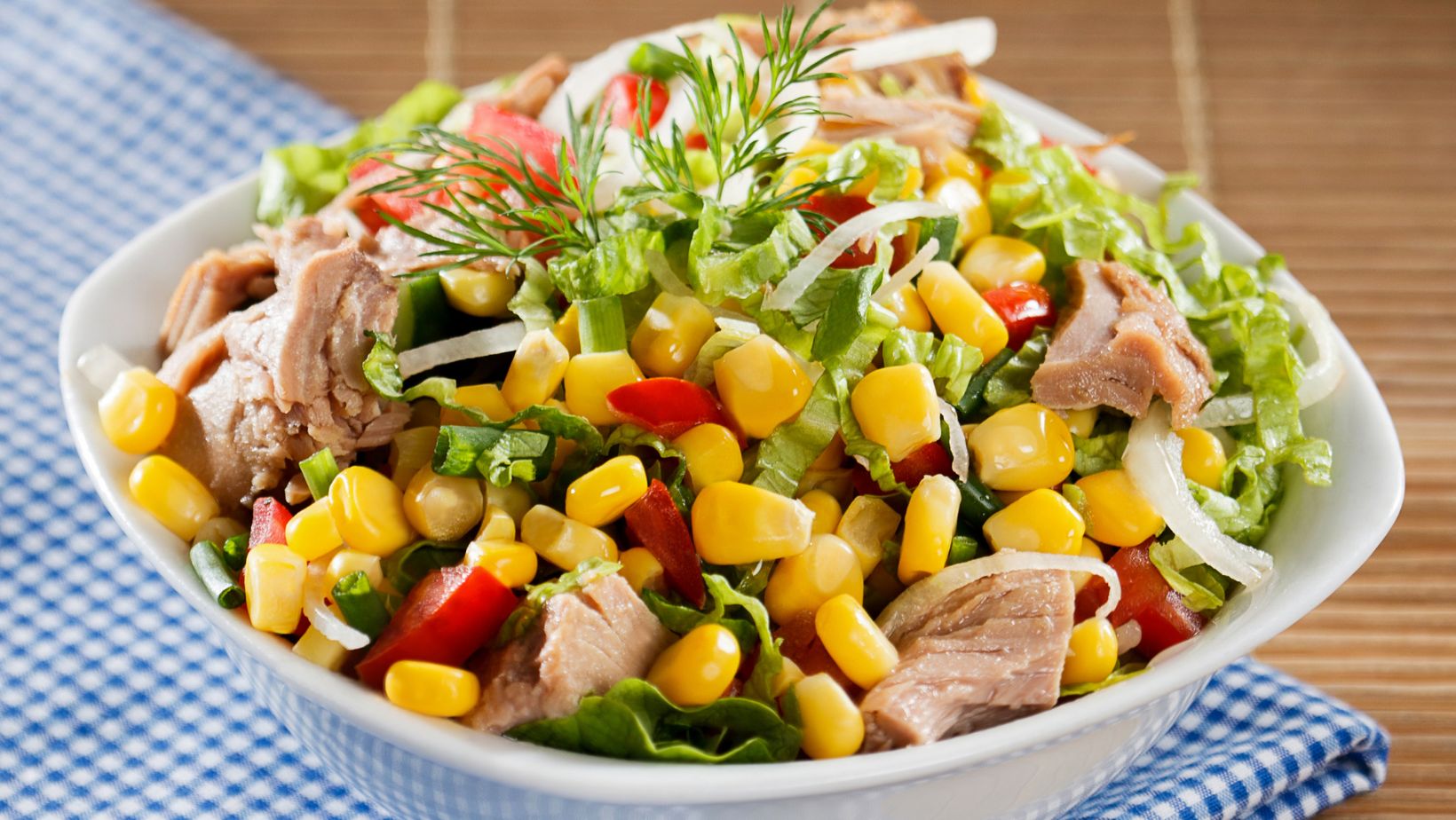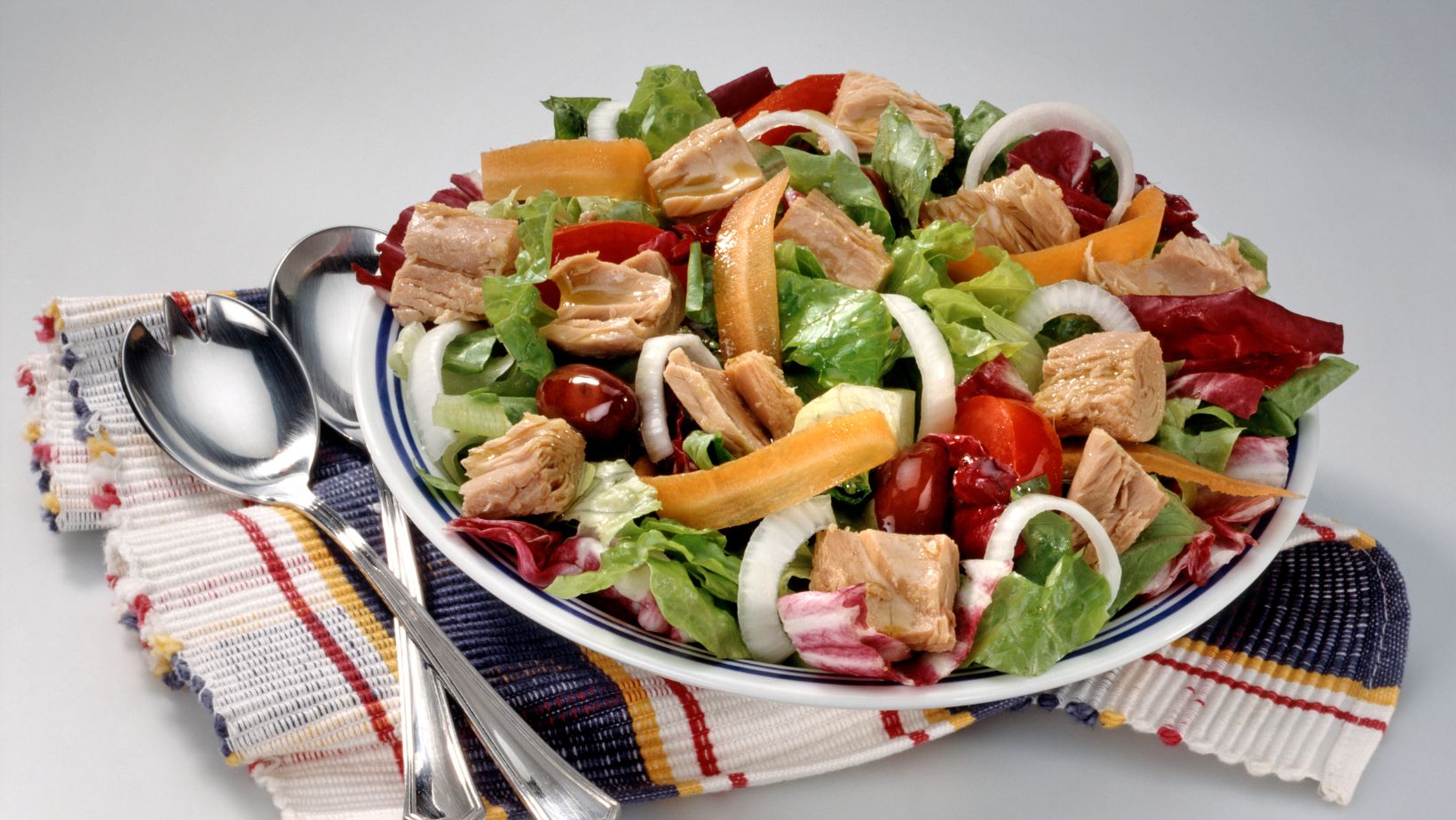
The Process of Making a Delicious And Authentic Tuna Salad at Home
What to Put in Tuna Salad
To create a scrumptious tuna salad, pack it with authentic ingredients like tuna, vegetables, herbs and seasonings, as well as a delicious sauce. In this section, we will explore the most essential ingredients that you need to whip up a perfect tuna salad at home. Keep reading as we delve into the nitty-gritty of each sub-section.
Tuna
Mix together tuna, celery, onion and mayo for a classic tuna salad. Add a zesty kick with Dijon mustard and balance out the flavors with capers or pickles. Use crunchy lettuce or mix it into pasta or quinoa for extra texture. For an even better dish, include avocado slices or cherry tomatoes. Give it flavor with fresh herbs like dill or parsley. Add some zing with citrus juice. Serve with crusty bread for a yummy lunchtime meal. Create your own unique tuna salad, full of nutrition and flavor!
Vegetables
Veggies are essential in tuna salad; they bring freshness, flavor and nutrition. Here are the best veggies for an authentic tuna salad:
- Lettuce: its mild flavor is a great match for tuna’s bold taste.
- Tomatoes: add juiciness, sweetness, tanginess and nutrition.
- Red Onions: earthy flavor plus tuna’s saltiness.
- Celery: subtle bitterness and freshness – plus, it’s a low-calorie filler.
- Capers: small but pack intense flavors – perfect with tuna salads!
- Fresh Herbs: basil, parsley or oregano add a one-of-a-kind flavor!
You could also add cucumbers or carrots for more diversity. But remember: veggies wilt quickly – so eat leftovers within 24 hours!
Herbs And Seasonings
For the best tasting Tuna Salad, mix together select natural ingredients. The seasoning is especially important! Include Kosher Salt for texture and taste, Fresh Cracked Black Pepper for spiciness and depth, Dried Oregano for a slightly bitter and pungent flavor, Capers for a bold, tangy and salty taste, Lemon juice for an acidic citrus sharpness, and Extra-virgin Olive oil for a bitter-tart effect.
For an even stronger aroma and fragrance, add some chopped fresh parsley leaves or basil leaves instead of dried herbs. If you’re feeling daring, put in a pinch of Cayenne pepper for a spicier kick without overpowering the tuna flavor. Remember, seasoning is key when crafting the perfect Authentic Tuna Salad!
Sauce
The dressing is key to an outstanding tuna salad. It should be light and tangy, to balance the richness of the tuna. Lemon juice, olive oil, Dijon mustard, salt and pepper make a perfect blend. Red onions or green onions, plus parsley or cilantro, bring subtle sweetness and herbal aroma. The secret is in balancing the flavors. A simple mix of lemon juice and olive oil can create a truly authentic tuna salad.
Preparing The Tuna
To prepare an authentic and delicious tuna salad at home, start with selecting the appropriate tuna and flaking it in the right way. This will significantly influence the taste and texture of your salad. In this section, you will understand the basics of choosing the perfect tuna and how to properly drain and flake it, which are the crucial first steps to making a great tuna salad.
Choosing The Right Tuna
Choose the right tuna for your dish with care. Fresh or canned are both options, but they have pros and cons. Fresh has a higher price and needs special handling, but offers a better quality. Canned is cheaper and simpler to store, but the flavor isn’t as good.
When choosing fresh tuna, pick cuts that are firm and have a light pink or reddish color. This means it’s fresh and flavoursome. It’s important to consider sustainability too. Overfishing can cause harm to ocean life.
To sum up, think about whether you want fresh or canned tuna. Choose cuts that are firm and pink/red. Also, select sustainable options to help protect the ocean and enjoy your meal.
Draining And Flake of The Tuna
Ready to open that can of tuna? The next step is to drain and flake it. Here’s a quick guide to help you out:
- Open the can – use a can opener or pull tab
- Drain the liquid – hold the lid over the can and press down gently
- Flake – use a fork to break it into small pieces
Don’t flake too much, otherwise it could break down too much. And don’t use a food processor or blender, as it’ll turn it into mush!
Adding herbs like parsley and dill can make the tuna taste delicious in sandwiches, dips, or salads. Salt & pepper with mayonnaise also work great.
Serve it straight away or store in the fridge for later. Enjoy!

Preparing The Vegetables
To prepare the vegetables for your delicious and authentic tuna salad at home, select the right vegetables and wash and chop them appropriately. Choosing fresh and crisp vegetables is essential for the best flavour and texture. In this section, we will be discussing the sub-sections of selecting the right vegetables and washing and chopping them to get the perfect bite in every fork.
Selecting The Right Vegetables
When picking veggies for a dish, there are several things to consider. Firstly, make sure they’re not overly ripe or wilted. Fresh produce is best.
Secondly, organic vegetables are advantageous as they don’t contain dangerous pesticides or chemicals.
Thirdly, look at the season. In-season veggies are much cheaper and tastier than out-of-season ones.
Then, colour and texture can add extra flair! Brighter veggies are high in vitamins, while a mix of crunchy veggies can bring balance and flavour to your meal.
Lastly, these methods are successful when adapted to personal preferences and recipe needs.
Washing And Chopping the Vegetables
Clean & Prepare Veggies
To eat healthy and safe veggies, cleaning and preparing are essential. Here’s a guide on how to do it!
|
1. Wash ’em: |
Rinse the veggies under water. Rub with your hands to remove dirt. Use a veggie brush for harder ones like potatoes and carrots. Dry them with a clean cloth or paper towel. |
|
2. Chop ’em: |
Cut the stems off and peel where needed. Chop them as needed for the recipe. Slice them uniformly for even cooking. |
|
3. Store ’em: |
If not using immediately, store the prepped veggies in the fridge. |
Remember to always wash your hands first before washing the veggies, to reduce contamination. Keep them in the refrigerator until you use them.
Adding Herbs And Seasonings
To add delicious flavor to your tuna salad in the most authentic and appetizing way, use herbs and seasonings. The two sub-sections that we’ll discuss here are adding flavor to tuna salad and using the right amount of herbs. By mastering these techniques, you can turn your tuna salad into a delectable and satisfying dish that satisfies your taste buds.
Adding Flavor to Tuna Salad
A tasty tuna salad can be made with herbs and seasonings! Here are some ideas:
- Fresh dill or parsley for a zesty burst.
- Spices like black pepper, garlic powder, or paprika for complexity.
- Lemon juice or vinegar for a bright flavor.
Also, chopped celery or onions add depth. Experiment with different herbs and spices to make a tuna salad just the way you like it!
Using the Right Amount of Herbs
Herbs are key for tasty dishes! But, the amount matters. Too much or too little can ruin the taste. Here’s what to keep in mind:
- Not too much – Start small.
- Fresh herbs – Fresher herbs have more aroma and flavor than dried.
- Intensity – Stronger herbs like Rosemary with lamb, milder ones like Parsley with chicken.
- Don’t overpower – Too many herbs can ruin a dish.
- Timing – Basil last, Rosemary throughout cooking.
- Let it sit – Compensate for 10 minutes before serving.
Finding the perfect ratio is a matter of trial and error. Good cooks trust their instincts more than numbers. To get the best out of herbs, one must know which type goes with which food. Get to know your ingredients!

Making The Sauce
To make the perfect sauce for your tuna salad with the right flavors that will hit your taste buds, you need to follow certain techniques and methods. In this segment, we will discuss the secrets of making the ideal sauce for your tuna salad. You will learn the importance of choosing the right sauce to complement your tuna salad and how to combine it perfectly.
Choosing the Right Sauce
Selection of the Perfect Sauce: Picking the right sauce can hugely influence the taste and texture of your meal. Here are six vital aspects to consider while deciding on a sauce:
- Match the flavour and intensity of your dish with the style of sauce.
- Determine the spiciness which is suited to your taste.
- Choose between store-bought or homemade sauces depending on time and preference.
- Pick sauces that adhere to dietary requirements, like gluten-free, low-sugar, low-sodium, vegan, and vegetarian options.
- Work to accompany the main ingredients rather than overpower them with your chosen sauce.
- Remember the temperature it needs to be served at; some sauces may need adjustments when cooking or reheating.
Moreover, it is essential to match the sauce to the regional cuisine and ingredients used. This will help bring out the original flavours that blend perfectly with traditional recipes. Remember to take into account the sauce consistency; for instance, marinades should be easy to put on and thinner sauces add moisture without taking away from the dish’s texture.
To sum up, choose sauces that enhance the chief ingredients of your dish without masking their natural taste. With these tips you can bring out unique flavours in any type of cuisine.
Combining the Sauce with Tuna Salad
Mix the delectable sauce with the scrumptious tuna salad by following these steps!
- Ensure both the ingredients are at room temp. This prevents a big change in temperature and helps with mixing.
- Spoon a generous amount of sauce over the salad without overpowering the flavours.
- Fold them together with a spatula until they combine well.
- Taste and adjust seasoning according to your preference. Add salt or pepper if you wish.
Garnish with fresh herbs like parsley or dill. Enjoy this yumminess!
Mixing It Up
To mix up your tuna salad with the right ingredients and perfect flavor, explore the sub-sections: Combining Tuna, Vegetables, and Sauce, and Mixing All Ingredients Together for Better Flavor.
Combining Tuna, Vegetables, and Sauce
Tuna, veggies and sauce are a great combo for a yummy and nutritious meal. They offer a range of textures and flavors to mix up in different ways. Here are 3 ideas:
- Stir-fry tuna and veggies. Heat oil in a pan, then sauté diced carrots, peppers, onions, broccoli and snap peas. Add tuna, cook until warm. Top with your favorite sauce.
- Toss a salad: chopped lettuce or spinach, cucumbers, tomatoes, radishes, avocados and tuna. Mix dressing with yogurt or mayo.
- Combine in pasta dish. Cook al dente. Sauté veggies in olive oil, garlic and onion until tender. Add chopped tomatoes, salt and pepper. Flake tuna into the mixture. Mix with sauce over cooked pasta.
Herbs or spices, like basil, thyme or mustard powder, can give each dish an extra unique flavor. Flexible preparation and individual tastes make this combo a delicious success!
Mixing All Ingredients Together for Better Flavor
For delicious dishes, combining ingredients is key. Here are five tips for mixing ingredients for the best flavor:
- Prepare each ingredient ahead of time, making sure it is fresh and clean.
- Measure everything to the recipe’s specifications. This will balance the flavors.
- Start with harder (dry) ingredients, then gradually add wetter ones such as oils or liquids. This prevents lumps or clumps.
- Stir the mix in a circular motion, adding each ingredient slowly and continuously. This helps each ingredient blend in.
- Taste test at every step. Adjust seasoning or other ingredients if needed.
Mixing ingredients is important for great flavor. But, techniques like preparation or cookware can also change the taste. To perfect the art of combining ingredients, you need patience and practice. But the result is restaurant-level dishes from your home kitchen!

Serving And Storing Tuna Salad
To ensure the freshness and taste of your delicious homemade tuna salad, you need to be mindful of how you serve and store it. In order to give you a better understanding, we will now talk about how to handle tuna salad, including serving and storing it properly. In the following sub-sections, we will briefly discuss serving tuna salad and storing it for later use.
Serving Tuna Salad
Tuna Salad presentation is key. Make it fresh and nutritious, and appealing to the eye. Taste matters, but looks are important too. Here’s a 3-step guide for Serving Tuna Salad:
- Pick a plate that goes with the salad color
- Serve right away for freshness
- Garnish with herbs like chives or parsley (optional)
Remember, keep your salad chilled before serving. Leftovers can last up to 3 days in an airtight container in the fridge.
Storing Tuna Salad for Later Use
Enjoying Your Leftover Tuna Salad
Tuna salad can be a delicious and versatile dish. But, if you make too much, you may want to store some for later. Here’s how:
|
1. Get the right container: |
Buy an airtight container that keeps your tuna salad fresh. |
|
2. Pack it right: |
Put it in smaller portions, so air won’t get trapped inside. This can cause bacteria and spoilage. |
|
3. Refrigerate fast: |
Put the containers in your refrigerator within two hours of making it. |
|
4. How long to store: |
Keep the salad in the fridge for up to 3 days before eating it. |
Discard any leftovers that have been unrefrigerated for more than two hours or show signs of spoilage (unusual smell, texture or color).
By following these steps, you can enjoy your leftover tuna salad and stay safe. Remember, storing it for too long can negatively affect its taste and quality. So, it’s better to eat it sooner rather than later.
